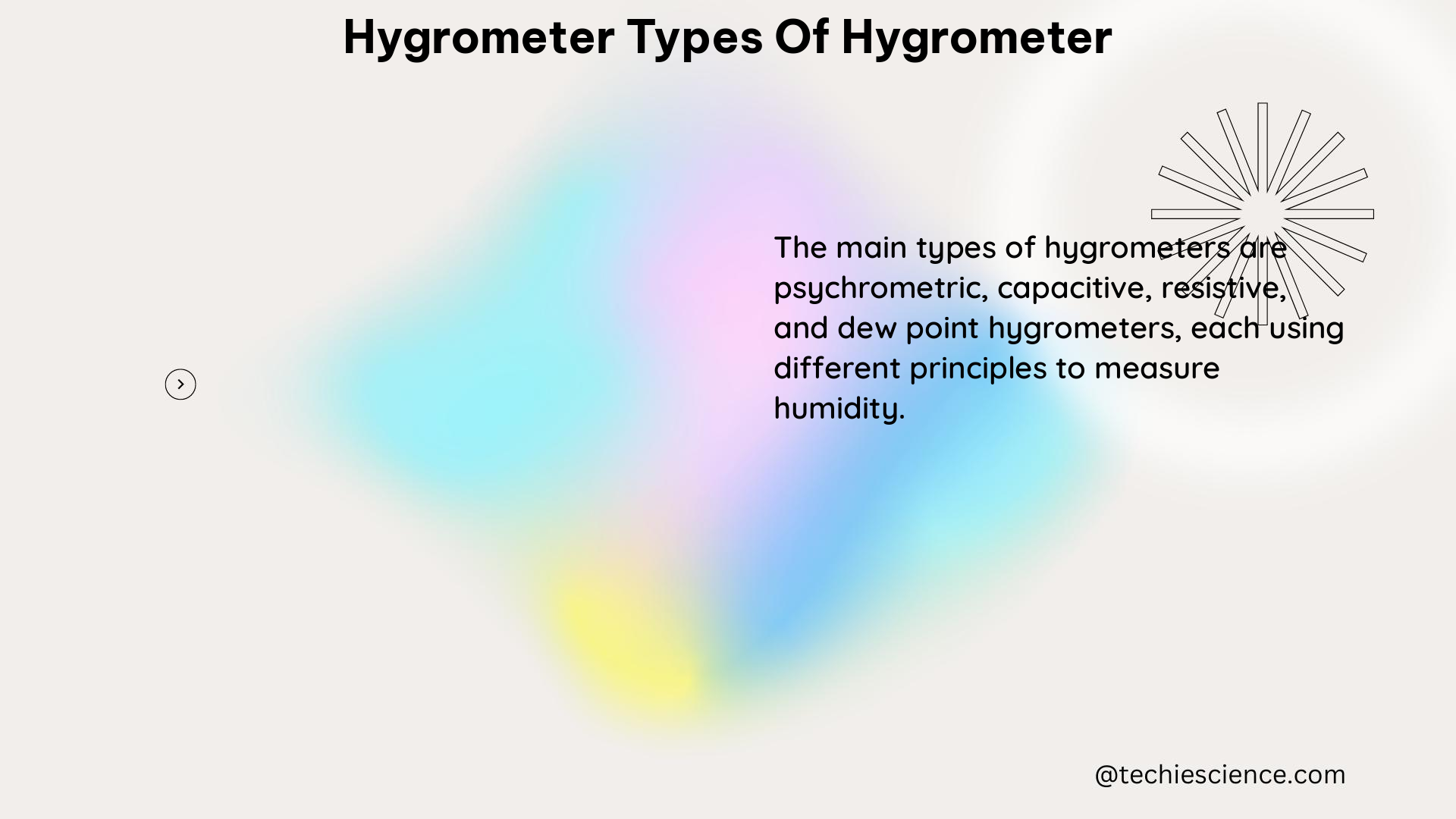Hygrometers are essential instruments used to measure the humidity of air or other gases. These devices operate on various principles, each offering unique advantages and limitations. This comprehensive guide delves into the technical details of the main types of hygrometers, providing a valuable resource for physics students and professionals alike.
Capacitive Hygrometers
Capacitive hygrometers are a popular choice for humidity measurement due to their robust design and relatively high accuracy. These instruments operate on the principle of measuring the effect of humidity on the dielectric constant of a polymer or metal oxide material.
Accuracy: Capacitive hygrometers can achieve an accuracy of ±2% RH (relative humidity) when properly calibrated. However, when uncalibrated, their accuracy can be two to three times worse.
Operating Principle: The dielectric material in a capacitive hygrometer absorbs or desorbs water molecules as the humidity changes, altering the dielectric constant of the material. This change in capacitance is then measured and converted into a humidity reading.
Advantages:
– Robust against condensation and temporary high temperatures
– Relatively stable over time, with minimal drift
Disadvantages:
– Subject to contamination, which can affect the dielectric properties and lead to inaccurate readings
– Aging effects can cause gradual drift in the sensor’s performance over time
Numerical Example: Consider a capacitive hygrometer with a measurement range of 0-100% RH. If the sensor is calibrated to an accuracy of ±2% RH, then a reading of 50% RH would have an uncertainty range of 48-52% RH.
Resistive Hygrometers

Resistive hygrometers measure the change in electrical resistance of a material due to variations in humidity. These sensors are known for their robustness against condensation, making them suitable for a wide range of applications.
Accuracy: Resistive hygrometers can achieve an accuracy of up to ±3% RH.
Operating Principle: The resistive material in the hygrometer, such as a polymer or ceramic, changes its electrical resistance as it absorbs or desorbs water molecules in response to changes in humidity. This resistance change is then measured and converted into a humidity reading.
Advantages:
– Robust against condensation
– Relatively simple and cost-effective design
Disadvantages:
– Require more complex circuitry compared to capacitive hygrometers
– Can be affected by temperature changes, which can influence the resistance of the sensing material
Numerical Example: Suppose a resistive hygrometer has a measurement range of 10-90% RH and an accuracy of ±3% RH. If the sensor reads 70% RH, the actual humidity value would be within the range of 67-73% RH.
Thermal Hygrometers
Thermal hygrometers, also known as psychrometric hygrometers, measure the absolute humidity of air rather than relative humidity. These instruments rely on the principle of measuring the change in thermal conductivity of air due to its moisture content.
Accuracy: Thermal hygrometers provide a direct measurement of absolute humidity, rather than relative humidity. The accuracy of these instruments depends on the specific design and the chosen resistive material.
Operating Principle: Thermal hygrometers use two thermometers, one of which is kept wet (wet-bulb) and the other dry (dry-bulb). The difference in temperature between the two thermometers is used to calculate the absolute humidity of the air.
Advantages:
– Can measure absolute humidity, which is useful in certain applications
– Relatively simple and cost-effective design
Disadvantages:
– Accuracy and robustness can vary depending on the chosen resistive material
– Require careful calibration and maintenance to ensure reliable measurements
Numerical Example: Suppose the dry-bulb temperature of the air is 25°C, and the wet-bulb temperature is 20°C. Using psychrometric tables or equations, the absolute humidity of the air can be calculated to be approximately 12.8 g/m³.
Gravimetric Hygrometers
Gravimetric hygrometers are considered the most accurate primary method for measuring absolute humidity. These instruments use a direct weighing process to determine the water content in the air.
Accuracy: Gravimetric hygrometers are the most accurate method for measuring absolute humidity, with the ability to achieve high precision.
Operating Principle: Gravimetric hygrometers work by extracting the water from a known volume of air and then weighing the water separately. The temperature, pressure, and volume of the resulting dry gas are also measured to calculate the absolute humidity.
Advantages:
– Highly accurate, making them the primary reference for calibrating other humidity measurement instruments
– Provide a direct measurement of absolute humidity
Disadvantages:
– Inconvenient to use, as they require complex setup and procedures
– Typically only used in laboratory settings or for calibrating less accurate instruments
Numerical Example: Suppose a gravimetric hygrometer is used to measure the absolute humidity of air at a temperature of 20°C and a pressure of 1 atm. If the instrument measures 10 grams of water extracted from 1 cubic meter of air, the absolute humidity would be calculated as 10 g/m³.
Mechanical Hygrometers
Mechanical hygrometers are among the oldest types of humidity measurement instruments. These devices use physical moving parts to measure the moisture content, often relying on the contraction and expansion of organic substances like human hair.
Accuracy: Mechanical hygrometers are generally less accurate compared to modern electronic sensors, with typical accuracies in the range of ±5-10% RH.
Operating Principle: Mechanical hygrometers use the dimensional changes of organic materials, such as human hair or animal fur, in response to changes in humidity. These changes in length or shape are then translated into a humidity reading.
Advantages:
– Simple and inexpensive design
– Can provide a visual indication of humidity levels
Disadvantages:
– Lower accuracy compared to electronic sensors
– Susceptible to environmental factors like temperature and aging of the organic materials
Numerical Example: A mechanical hygrometer with a measurement range of 0-100% RH and an accuracy of ±5% RH may display a reading of 60% RH. In this case, the actual humidity value would be within the range of 55-65% RH.
Psychrometers
Psychrometers are a type of hygrometer that measure humidity through the process of evaporation. These instruments use the temperature difference between a wet-bulb and a dry-bulb thermometer to determine the humidity of the air.
Accuracy: Psychrometers measure humidity through evaporation, using the temperature difference between a wet and dry thermometer. The accuracy of psychrometers can vary, but they are generally less accurate than modern electronic sensors.
Operating Principle: Psychrometers utilize two thermometers, one with a wet-bulb and one with a dry-bulb. The wet-bulb thermometer measures the temperature of the air as it is cooled by the evaporation of water, while the dry-bulb thermometer measures the actual air temperature. The difference between these two temperatures is then used to calculate the relative humidity.
Advantages:
– Simple and cost-effective design
– Can provide a direct measurement of relative humidity
Disadvantages:
– Less accurate than modern electronic sensors
– Require careful calibration and maintenance to ensure reliable measurements
Numerical Example: Suppose the dry-bulb temperature is 25°C, and the wet-bulb temperature is 20°C. Using psychrometric tables or equations, the relative humidity can be calculated to be approximately 65%.
Dew-Point Hygrometers
Dew-point hygrometers are a specialized type of hygrometer that measure the dew point, which is the temperature at which moisture starts to condense from the air.
Accuracy: Dew-point hygrometers can provide accurate measurements of the dew point, which is a direct indicator of the absolute humidity of the air.
Operating Principle: Dew-point hygrometers use a polished metal mirror that is cooled at a constant pressure and constant vapor content. As the mirror is cooled, the temperature at which moisture just starts to condense on the mirror surface is the dew point.
Advantages:
– Can provide accurate measurements of the dew point, which is a direct indicator of absolute humidity
– Useful in applications where precise humidity control is required
Disadvantages:
– The setup and operation of dew-point hygrometers can be more complex compared to other types of hygrometers
– Require careful calibration and maintenance to ensure reliable measurements
Numerical Example: Suppose a dew-point hygrometer measures a dew point of 15°C in an air sample. Using the Clausius-Clapeyron equation or psychrometric tables, the absolute humidity of the air can be calculated to be approximately 12.8 g/m³.
In conclusion, this comprehensive guide has provided a detailed overview of the various types of hygrometers, their operating principles, accuracy, advantages, and disadvantages. By understanding the technical specifications of each hygrometer type, physics students and professionals can make informed decisions when selecting the most appropriate instrument for their specific humidity measurement needs.
Reference:
– Humidity Measurement Principles, Practices, and Calibration
– Hygrometer Types and Their Characteristics
– Psychrometric Principles and Calculations
– Dew Point Measurement and Calculation

I am Subrata, Ph.D. in Engineering, more specifically interested in Nuclear and Energy science related domains. I have multi-domain experience starting from Service Engineer for electronics drives and micro-controller to specialized R&D work. I have worked on various projects, including nuclear fission, fusion to solar photovoltaics, heater design, and other projects. I have a keen interest in the science domain, energy, electronics and instrumentation, and industrial automation, primarily because of the wide range of stimulating problems inherited to this field, and every day it’s changing with industrial demand. Our aim here is to exemplify these unconventional, complex science subjects in an easy and understandable to the point manner.